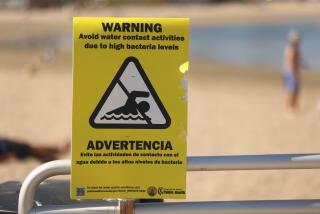Water Board Targets Ocean Bacteria
State water officials on Thursday took their first step toward controlling unhealthful levels of bacteria that are flushed into Santa Monica Bay after heavy rainstorms.
The new rules cover 44 beaches that stretch from the Los Angeles-Ventura County line to Outer Cabrillo Beach south of Palos Verdes Peninsula.
The regulations give local government officials 10 to 18 years to reduce the number of days that water-borne bacteria can exceed human health standards in waters near shore.
Bacteria in the ocean from urban runoff, pet droppings and leaking sewage pipelines have caused stomach and respiratory ailments.
âBanning bacteria is the most important thing that weâve done to protect human health,â said Francine Diamond, chairwoman of the Los Angeles Regional Water Quality Control Board. âThis will help future generations as they go to the beach, protecting the health of children, swimmers and surfers who come in contact with the water.â
Earlier this year, state officials ordered cities and the county to clean up bacterial pollution during rain-free days in Santa Monica Bay so that all of its beaches are safe during the most popular months for swimming. Cities have three years to meet these dry-weather standards.
The rules adopted Thursday by the regional board tackle the tougher problem of diverting or treating the bacteria swept into the ocean during rainy days.
Environmentalists said the new bacterial standards should be especially helpful in protecting the health of surfers, bodysurfers and knee-boarders who are drawn to the same storm-driven surf that catches the most polluted runoff.
Opposing the rules, the Coalition for Practical Regulation, representing a number of coastal cities, argued that too few people enter the ocean on such days to justify the cleanup cost.
Jeff Hobbs, a coalition spokesman, said state officials have failed to do a cost-benefit analysis that proves the need for such expensive regulations. âThe state is not paying for this. The local taxpayers are,â Hobbs said. âWe think these regulations should be in the best interest of the public, not just on some environmentalistsâ agenda.â
Mark Gold, executive director of the environmental group Heal the Bay, said all members of the public deserve health protections guaranteed 30 years ago by the U.S. Clean Water Act. âThe die-hards who swim or surf during the winter deserve just as much protection as those who go in the ocean during the summer,â he said.
The crackdown on bacterial pollution is part of a larger campaign against an array of pollutants outlined in the settlement of a lawsuit filed by environmentalists.
In addressing limits on bacterial pollution, the regional board decided against setting an absolute threshold that could not be breached, noting that suspect bacteria does not always come from human sewage or other man-made causes. Instead, bird droppings and wildlife waste and even rotting vegetation can elevate levels of harmful bacteria.
For most areas north of Los Angeles, health standards for bacteria can be exceeded a maximum of 17 days during wet weather each year. Other beaches, particularly the cleaner ones in the South Bay, will be allowed only six âdirtyâ days.
The new rules will be a major change for some beaches. The popular Surfrider Beach in downtown Malibu, for instance, exceeded bacteria standards 47 days, on average, during the rainy season.
Cities and the county have 10 years to meet these standards, by upgrading leaky septic tanks, fortifying sewage lines and diverting urban-runoff pollutants carried into storm drains.
Some action will have to begin sooner. The standards will be phased in, requiring a 25% reduction in the number of days exceeding bacteria standards within six years and a 50% reduction within eight years.
The city of Los Angeles will be given up to 18 years because of an approach that combines reducing pollutants and capturing half of the cityâs runoff so that it can percolate into the earth to recharge the groundwater.
The new rules on bacteria, the result of three years of negotiations by experts, state and local governments and environmentalists, do not mean the ocean will be free of human-generated bacteria. It uses a federal standard of acceptable risk in marine waters: No more than 19 of 1,000 people exposed will get sick.
âItâs not everything we wanted,â said Steve Fleischli, director of Santa Monica BayKeeper. âThere are some legal deficiencies.â
More to Read
Sign up for Essential California
The most important California stories and recommendations in your inbox every morning.
You may occasionally receive promotional content from the Los Angeles Times.










